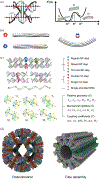Design Approaches and Computational Tools for DNA Nanostructures
- PMID: 35756857
- PMCID: PMC9232119
- DOI: 10.1109/ojnano.2021.3119913
Design Approaches and Computational Tools for DNA Nanostructures
Abstract
Designing a structure in nanoscale with desired shape and properties has been enabled by structural DNA nanotechnology. Design strategies in this research field have evolved to interpret various aspects of increasingly more complex nanoscale assembly and to realize molecular-level functionality by exploring static to dynamic characteristics of the target structure. Computational tools have naturally been of significant interest as they are essential to achieve a fine control over both shape and physicochemical properties of the structure. Here, we review the basic design principles of structural DNA nanotechnology together with its computational analysis and design tools.
Keywords: DNA; computational tools; design principle; nanotechnology.
Figures






Similar articles
-
DNA-based construction at the nanoscale: emerging trends and applications.Nanotechnology. 2018 Feb 9;29(6):062001. doi: 10.1088/1361-6528/aaa120. Nanotechnology. 2018. PMID: 29232197 Review.
-
Advancing Wireframe DNA Nanostructures Using Single-Molecule Fluorescence Microscopy Techniques.Acc Chem Res. 2019 Nov 19;52(11):3199-3210. doi: 10.1021/acs.accounts.9b00424. Epub 2019 Nov 1. Acc Chem Res. 2019. PMID: 31675207 Review.
-
Structural DNA Nanotechnology: Artificial Nanostructures for Biomedical Research.Annu Rev Biomed Eng. 2018 Jun 4;20:375-401. doi: 10.1146/annurev-bioeng-062117-120904. Epub 2018 Apr 4. Annu Rev Biomed Eng. 2018. PMID: 29618223 Review.
-
Building DNA nanostructures for molecular computation, templated assembly, and biological applications.Acc Chem Res. 2014 Jun 17;47(6):1778-88. doi: 10.1021/ar500023b. Epub 2014 Apr 10. Acc Chem Res. 2014. PMID: 24720350
-
Chemistries for DNA Nanotechnology.Chem Rev. 2019 May 22;119(10):6384-6458. doi: 10.1021/acs.chemrev.8b00570. Epub 2019 Feb 4. Chem Rev. 2019. PMID: 30714731 Review.
Cited by
-
Nucleic acid nanostructures for in vivo applications: The influence of morphology on biological fate.Appl Phys Rev. 2023 Mar;10(1):011304. doi: 10.1063/5.0121820. Appl Phys Rev. 2023. PMID: 36874908 Free PMC article. Review.
-
Improving DNA nanostructure stability: A review of the biomedical applications and approaches.Int J Biol Macromol. 2024 Mar;260(Pt 1):129495. doi: 10.1016/j.ijbiomac.2024.129495. Epub 2024 Jan 14. Int J Biol Macromol. 2024. PMID: 38228209 Free PMC article. Review.
References
-
- Seeman NC, “Nucleic acid junctions and lattices,” J. Theor. Biol, vol. 99, no. 2, pp. 237–247, 1982. - PubMed
-
- Rothemund PWK, “Folding DNA to create nanoscale shapes and patterns,” Nature, vol. 440, no. 7082, pp. 297–302, 2006. - PubMed
-
- Pfeifer W and Saccà B,“From nano to macro through hierarchical self-assembly: The DNA paradigm,” ChemBioChem, vol. 17, pp. 1063–1080, 2016. - PubMed
Grants and funding
LinkOut - more resources
Full Text Sources
